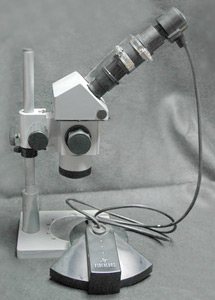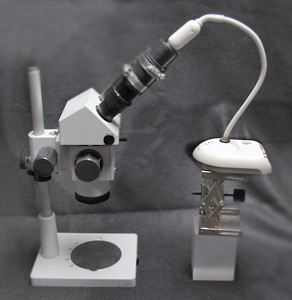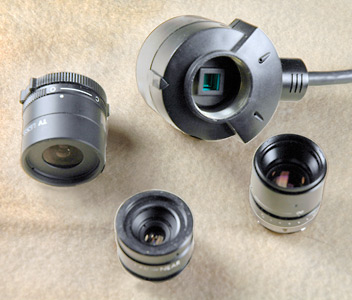The captured images needed to be resized to 320x240 to appear sharp. Most of the images in the mineral section of this site, that are shown at 320x240 resolution, were taken with this camera or one like it. Today there are numerous external "boxes" that can be purchased that will convert a live video signal to either a USB or Firewire port. Checkout companies like Canopus, USBGear, ElGato, Datavideo, and Daystar.
 |
 |
|---|---|
|
Flexcam on scope
|
Sony flexible camera on scope
|
These live video cameras (not digitized) are rated by TV scan lines, and typically run between about 330 lines to 480 lines. This video image must be converted to a digital resolution, and a video input can be connected to virtually any conversion device, so a 330 line camera can be converted to 640x480 resolution, but a 330 line camera likely has a lower resolution ccd cell and should be converted to lower resolution. The camera's ccd should determine the one-to-one resolution that the camera can deliver. This specification is often hard to find. The 480 line resolution is about 400K pixels total, or roughly 768x520 resolution.
These small cameras tend to have pretty good light capture with 3 LUX of less. LUX is a measurement of the luminance needed for image capture. A full-moon is about 0.25 LUX and a candle is about 10 LUX. The cameras work without the microscope too, and many have c-mount lenses that can be interchanged for a multitude of focal lengths. (See photo below for example c-mount lenses.)
 |
Higher resolution at lower cost is now available with commercial still-photography digital cameras, but the small live-video cameras can typically collect data at their full resolution and between 15 and 30 frames per second So they can do live video! I have used this type of camera to make small movies through the microscope and to provide live video feeds of desktop demonstrations.
For most still images I would most likely recommend a still digital camera as they are less expensive per pixel and are more portable. For live video work either a DV camera adapted to the scope or one of the small video cameras would both work. The DV camera would have the advantage of portability as the live video needs to be connected to a digitizer and like a computer for data collection. The disadvantage of the DV camera is its size and the need to make a good stationary fit on the microscope. DV cameras can easily be mounted on third-tube scopes, but it is more of a challenge to mount them on the oculars. The smaller cameras are easy to mount, and small video cameras can be connected directly to a TV or projection monitor for live demonstrations and wide area display in real time. |
|
Flexcam head with c-mount lenses
|